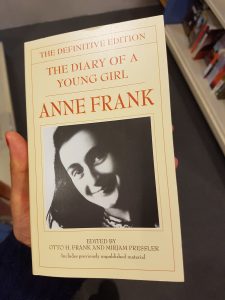The Diary of a Young Girl is an account of Anne Frank’s experience in hiding during the Holocaust. Not only does her narrative provide an accurate representation of the challenges that faced the Jewish community during the Nazi regime, but her innermost thoughts and feelings are captured within the pages, illustrating her spirit and vivacity and portraying the legitimacy of the adolescent voice. Undoubtedly, reading the diary would allow an individual to extract information about Anne’s character and her story, but the peritextual evidence (the physical elements of the published autobiographical text) is indicative of Anne’s character and her story as well. Ultimately, the peritextual evidence prepares the reader for the contents of the text and strategically piques the reader’s interest to create a marketable book.
Firstly, the colour of the book is notable. The pale yellow cover is symbolic of various features of the narrative. For example, it provides immediate information about the year the diary was written. The pale yellow colour, similar to the pale yellow of aged paper, depicts a story describing times past. At the same time, the yellow of the cover and the red of the text on the cover can be analyzed to represent Anne’s character. Yellow, particularly in literature, tends to symbolize happiness, intellect, and, curiosity (Color-meanings.com)– all of which are personality descriptors that reflect Anne’s character. When she writes in her diary that one should “go outside and try to recapture the happiness within yourself; think of all the beauty in yourself and in everything around yo u and be happy” (Frank, 7 March, 1994), her optimism secures contentment and peace within her heart, reinforcing her happy personality. Red appears to be suggestive of passion, love, and courage, but also depicts danger (Colour-meanings.com). Anne is in a perilous situation, but she manages to face the challenging circumstances with strength and ferocity. She describes it herself: “I know what I want, I have a goal, an opinion, I have a religion and love. Let me be myself and then I am satisfied. I know that I’m a woman, a woman with inward strength and plenty of courage” (Frank, 11 April 1944). Altogether, the colours utilized on the cover of the text permit the reader to establish conclusions on the context of the narrative– particularly the young writer’s character– without even reading the text itself.
u and be happy” (Frank, 7 March, 1994), her optimism secures contentment and peace within her heart, reinforcing her happy personality. Red appears to be suggestive of passion, love, and courage, but also depicts danger (Colour-meanings.com). Anne is in a perilous situation, but she manages to face the challenging circumstances with strength and ferocity. She describes it herself: “I know what I want, I have a goal, an opinion, I have a religion and love. Let me be myself and then I am satisfied. I know that I’m a woman, a woman with inward strength and plenty of courage” (Frank, 11 April 1944). Altogether, the colours utilized on the cover of the text permit the reader to establish conclusions on the context of the narrative– particularly the young writer’s character– without even reading the text itself.
Another observable feature that captures the reader’s attention are the capitalized words on the back cover claiming that this book is “the first complete and intimate version…” of Anne’s diary. The summary on the back cover also asserts that the book is “a new edition enriched by many passages originally withheld by her father…” This develops intrigue for the consumer, comparable to the intrigue that magazines and advertising companies manage to produce in consumers. Headlines in magazines and advertising that promise “new discoveries” and the “inside scoop” engage human psychology. The proposal that this particular b ook includes details that other readers do not have access to almost seems to mirror the idea of gossip (NPR). By manipulating the human folly of love for gossip, the capitalized statements compel the consumer to purchase the autobiographical text, because gossip, or “being in the know,” tends to garner a sense of belonging and social security that humans crave. By using this technique, publishers secure profits by making the book enticing, and therefore marketable.
ook includes details that other readers do not have access to almost seems to mirror the idea of gossip (NPR). By manipulating the human folly of love for gossip, the capitalized statements compel the consumer to purchase the autobiographical text, because gossip, or “being in the know,” tends to garner a sense of belonging and social security that humans crave. By using this technique, publishers secure profits by making the book enticing, and therefore marketable.
Altogether, peritextual evidence generates many implications for narratives. The subtle suggestions scattered throughout the peritext that describe contextual detail, coupled with the covert methods of manipulation used to convince
the reader to choose that particular text, all contribute to the presentation of a narrative, and hence construct the foundation for the business of publication. In regards to The Diary of a Young Girl, colour and typeface are two components of the peritext that establish a certain impression for the reader. In a society that says not to judge a book by its cover, the irony is that society is expected to do so; especially when all the efforts of publication staff are directed at breeding the correct physical features in order to cultivate a salable product.
Citations:
Frank, Anne. The Diary of a Young Girl: The Definitive Edition. Doubleday, 1995.
Olesen, Jacob. Color Symbolism in Literature: What Do Colors Mean in Literature and Poetry? Color-Meanings.com, http://www.color-meanings.com/color-symbolism-in-literature-what-do-colors-mean-in-literature-and-poetry, Accessed 5 October, 2016.
Hamilton, Jon. Psst! The Human Brain is Wired for Gossip, NPR, http://www.npr.org/2011/05/20/136465083/psst-the-human-brain-is-wired-for-gossip, Accessed 5, October 2016.